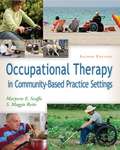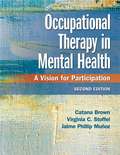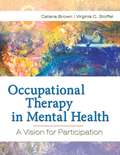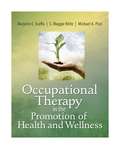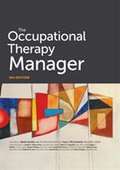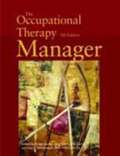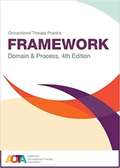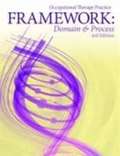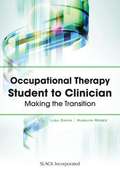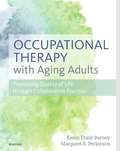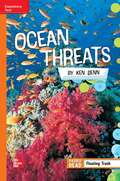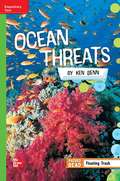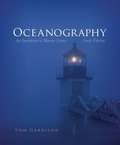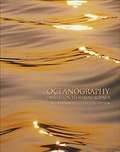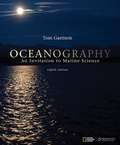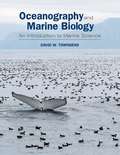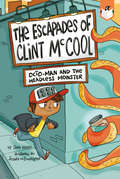- Table View
- List View
Occupational Therapy in Community-Based Practice Settings (2nd Edition)
by Marjorie E. Scaffa S. Maggie ReitzBe prepared for the growing opportunities to practice in community-based settings with the 2nd Edition of this groundbreaking resource. From basic principles and policy issues through the variety of settings to the future role of the OT, a noted authority in the field introduces you to all aspects of this rapidly expanding field of practice. You'll be prepared to take on new roles, to take unusual risks, and to envision service in creative ways. Reviews of the 1st Edition "This book is highly recommended not only to occupational therapy students and educators but to occupational therapy practitioners as well. For those employed in traditional hospital settings, the abundance of information may certainly help them expand their thinking about the scope of occupational therapy practice. " --Karen Butler Canadian Journal of Occupational Therapy "The text is easily readable and contains chapter key terms and learning objectives which help accentuate information. This text provides a much needed resource for occupational therapists who currently are, or plan to in the future, practice in the community. " --Peggy Wittman, EdD, OTR/L, FAOTA Occupational Therapy in Health Care Journal "Very comprehensive. Reviews a variety of possible settings for community practice and appears to cover the process from the beginning on through. " --Anne Marie Knecht, MA, OTR/L Florida International University, Miami, FL
Occupational Therapy In Mental Health: A Vision For Participation
by Catana Brown Virginia C. Stoffel Jaime MunozUses the Person-Environment-Occupation (PEO) model as a framework to promote the full participation in the lives of individuals with mental illness and those struggling with psychosocial issues related to their disabilities. <p><p> Features first-person “The Lived Experience," narratives that give voice to the experience of living with a mental illness <p> Incorporates “Photo Voice” features, a blend of photography and personal stories that enable individuals to record their visions and experiences to promote dialogue about important issues. <p> Addresses co-occurring conditions such as depression, stroke, substance abuse and spinal cord injury, and attention deficit disorder and learning disabilities. <p> Promotes best practices with “Evidence-Based Practice “boxes that synthesize significant research and implications for practice. <p> Offers extensive information on theory and evidence-based interventions <p> Employs active learning strategies to facilitate the application of knowledge, skills, and attitudes essential for mental health and psychosocial interventions. <p> Addresses occupational therapy in a variety of practice settings for individuals from all cultures across the life span. <p> Discusses non-diagnosis-based populations, such as the homeless, as well as the continuum of care from institution or hospital to the community.
Occupational Therapy In Mental Health: A Vision For Participation
by Catana Brown Virginia C. Stoffel Jaime Phillip MunozThis Client-centered, recovery-oriented text gives voice to the lived experience of mental illness across the life span. You will be guided through the assessment and interventions of individuals with mental health conditions and those whose life circumstances generate significant challenges to their participation in valued activities.
Occupational Therapy in the Promotion of Health and Wellness
by Marjorie E. Scaffa S. Maggie Reitz Michael A. PizziThis book teaches students about health promotion and prevention theory and practice from a wellness rather than an illness perspective. Using "cutting edge" examples, the authors explore how to incorporate this new paradigm into clinical practice and how to develop wellness interventions across the lifespan.
The Occupational Therapy Manager
by Karen Jacobs Guy McCormackIn today s health care, occupational therapy managers and leaders must be prepared to ensure delivery of high-quality care; staff morale and efficiency remain high; businesses and organizations are profitable; and the profession is recognized by other health care professionals, reimbursers, and clients as a valuable service steeped in evidence. The bestselling Occupational Therapy Manager can help occupational therapy practitioners become capable, effective leaders across all practice settings. This new edition includes 76 new chapters in 12 sections that cover leadership and management foundations, organizational planning and culture, navigating change and uncertainty, outcomes and documentation, interprofessional practice and teams, supervision, communication, finance and budgeting, professional standards, ethical and legal considerations, managing your career, and public policy. Each chapter includes learning objectives, key terms, essential considerations and practical applications in occupational therapy, a case example, and relevant ACOTE Standards. The most comprehensive management book in the profession, this is a fundamental, classic text for all occupational therapy students, practitioners, and managers.
Occupational Therapy Manager (Fifth Edition)
by Karen Jacobs Guy L. MccormackIn today's health care environment, occupational therapy practitioners in clinical and leadership positions must be prepared to ensure that clients receive the highest quality of care; staff morale and efficiency remain high; businesses and organizations are profitable; and the profession is recognized by other health care professionals, reimbursers, and clients as a valuable service steeped in evidence. The Occupational Therapy Manager, 5th Edition can help occupational therapy practitioners become capable, effective leaders across all practice settings. This new edition includes 37 new and updated chapters, discussing the how-to aspects of creating evidence-based practices; effectively leading and motivating staff; ensuring ethical service delivery; and important day-to-day items such as budgeting, documentation, and reimbursement. Chapters also are updated to reflect health care reform and its potential effects on occupational therapy. Highlights Include-- *Section I: Defining and Rethinking Management *Section II: Strategic Planning *Section III: Leading and Organizing *Section IV: Controlling Outcomes *Section V: Public Policy, Professional Standards, and Collaboration *Section VI: Supervision *Appendixes--Occupational Therapy Code of Ethics and Ethics Standards, Scope of Practice, and more The Occupational Therapy Manager is the best-selling and most comprehensive management book in the profession and is a fundamental, classic text for all occupational therapy students, practitioners, and managers.
Occupational Therapy Practice Framework: Domain & Process
by American Occupational Therapy AssociationThe Occupational Therapy Practice Framework: Domain and Process (OTPF) summarizes the interrelated constructs that describe occupational therapy practice. It is intended for a wide audience of occupational therapy practitioners and students, other health care professionals, educators, researchers, payers, and consumers. This 4th edition (the OTPF 4) continues its predecessors mission to provide structure and guidance for practitioners to achieve the distinct value of occupational therapy in the clinic and other settings. An American Occupational Therapy Association (AOTA) official document, the OTPF is reviewed on a 5-year cycle. The review period includes the voices of AOTA members, scholars, authors, practitioners, AOTA volunteer leadership and staff, and other stakeholders to ensure that the document maintains its integrity while responding to emerging concepts and advances in occupational therapy. The OTPF 4 includes the following changes: *Increased focus on group and population clients *Identification of the cornerstones of occupational therapy practice, foundational to the success of occupational therapy practitioners *More explicit description and definition of the terms occupational science, occupation, and activity *Changes in terminology to accord with the taxonomy from the World Health Organization s International Classification of Functioning, Disability and Health (ICF) *Inclusion of gender identity as a client factor under experience of self and time *Discussion of transitions and discontinuation as outcomes to occupational therapy services *Discussion of patient-reported outcomes *Five new tables to expand on and clarify concepts. The OTPF 4 represents the latest articulation of the occupational therapy domain and process, building on a set of values that the profession has held since its founding in 1917. Embedded in this document is the occupational therapy profession s core belief in the positive relationship between occupation and health and its view of people as occupational beings.
Occupational Therapy Practice Framework: Domain and Process
by American Occupational Therapy Association StaffAs occupational therapy celebrates its centennial in 2017, attention returns to the profession's founding belief in the value of therapeutic occupations as a way to remediate illness and maintain health. The founders emphasized the importance of establishing a therapeutic relationship with each client and designing an intervention plan based on the knowledge about a client's context and environment, values, goals, and needs. Using today's lexicon, the profession's founders proposed a vision for the profession that was occupation based, client centered, and evidence based--the vision articulated in the third edition of the Occupational Therapy Practice Framework: Domain and Process. <P><P>The Framework is a must-have official document from the American Occupational Therapy Association. Intended for occupational therapy practitioners and students, other health care professionals, educators, researchers, payers, and consumers, the Framework summarizes the interrelated constructs that describe occupational therapy practice. In addition to the creation of a new preface to set the tone for the work, this new edition includes the following highlights: a redefinition of the overarching statement describing occupational therapy's domain; a new definition of clients that includes persons, groups, and populations; further delineation of the profession's relationship to organizations; inclusion of activity demands as part of the process; and even more up-to-date analysis and guidance for today's occupational therapy practitioners. <P><P>Achieving health, well-being, and participation in life through engagement in occupation is the overarching statement that describes the domain and process of occupational therapy in the fullest sense. The Framework can provide the structure and guidance that practitioners can use to meet this important goal.
Occupational Therapy Student to Clinician: Making the Transition
by Lisa Davis Marilyn RoseeIt is an imperative need and a great challenge to support the professional development of competent OTs. The complexity of demands in the workforce exceeds the requisite of clinical knowledge and reasoning.
Occupational Therapy With Aging Adults: Promoting Quality Of Life Through Collaborative Practice
by Karen Barney Margaret PerkinsonLook no further for the book that provides the information essential for successful practice in the rapidly growing field of gerontological occupational therapy! Occupational Therapy with Aging Adults is a new, comprehensive text edited by OT and gerontological experts Karen Frank Barney and Margaret Perkinson that takes a unique interdisciplinary and collaborative approach in covering every major aspects of geriatric gerontological occupational therapy practice. With 30 chapters written by 70 eminent leaders in gerontology and OT, this book covers the entire continuum of care for the aging population along with special considerations for this rapidly growing demographic. This innovative text also covers topical issues spanning the areas of ethical approaches to treatment; nutrition and oral health concerns; pharmacological issues; low vision interventions; assistive technology supports; and more to ensure readers are well versed in every aspect of this key practice area.
Ocean, Atmosphere, and Climate: Cold Years in New Zealand, Investigation Notebook with Article Compilation
by The Lawrence Hall of ScienceNIMAC-sourced textbook
Ocean, Atmosphere, and Climate: Cold Years in New Zealand, Investigation Notebook with Article Compilation
by The Lawrence Hall of ScienceNIMAC-sourced textbook
Oceanography: An Invitation to Marine Science
by Tom GarrisonGarrison (Orange Coast College) covers the fundamentals of oceanography, including the history of marine science, earth structure and plate tectonics, seawater chemistry, and ocean physics. The textbook also discusses atmospheric circulation and weather, wave dynamics and wind waves, plant and animal life, marine communities, marine resources, and environmental concerns. Appendixes feature information on measures and conversions, geological time, latitude and longitude, maps and charts, taxonomic classification of marine organisms, careers in marine science, and calculating tide-generating force. Included is a CD-ROM with on-line materials for each chapter and other resources. Annotation c. Book News, Inc. , Portland, OR (booknews. com)
Oceanography: An Invitation to Marine Science (4th edition)
by Tom GarrisonThis edition provides an interesting, clear, current, and reasonably comprehensive overview of the marine sciences and is designed for college and university students who are curious about Earth's largest feature, but who may have little formal background in science.
Oceanography: An Invitation To Marine Science
by Tom S. GarrisonCengage Learning in partnership with National Geographic Society brings course concepts to life with interactive learning, study, and exam preparation tools along with market leading text content for introductory oceanography courses. OCEANOGRAPHY provides a basic understanding of the scientific questions, complexities, and uncertainties involved in ocean use, as well as the role and importance of the ocean in nurturing and sustaining life on the planet. Bestselling author Tom Garrison emphasizes the interdisciplinary nature of marine science, stressing its links to biology, chemistry, geology, physics, meteorology, astronomy, ecology, history, and economics. Enable your students to purchase the right solution to meet their needs, whether it's a traditional printed text, all digital learning platform, or package that includes the best of both worlds. With the recently updated Oceanography 8th Edition and CourseMate's interactive teaching and learning tools, it's never been easier to help students understand the complexities involved in how we study and use the ocean.
Oceanography and Marine Biology: An Introduction to Marine Science
by David W. TownsendOceanography and Marine Biology preserves the basic elements of the physical, chemical, and geological aspects of the marine sciences, and merges those fundamentals into a broader framework of marine biology and ecology. Existing textbooks on oceanography or marine biology address the companion field only cursorily: very few pages in oceanography texts are devoted to marine biology, and vice versa. This new book overcomes that imbalance, bringing these disparate marine science text formats closer together, giving them more equal weight, and introducing more effectively the physical sciences by showing students with everyday examples how such concepts form the foundation upon which to build a better understanding of the marine environment in a changing world. Lecturer supplements will also be available.
Oceans (Delta Science Readers)
by Delta EducationSalty ocean water covers about 71 percent of Earth's surface. Earth's four main oceans are the Pacific, the Atlantic, the Indian, and the Arctic. <P><P>The Pacific Ocean is so big that all the land on Earth could fit into it easily. The Arctic Ocean is the smallest ocean. But it is still bigger than the United States. All of Earth's oceans are connected. Water can move from one ocean into another. Together the four oceans make up one big world ocean. <P><P> The word sea is used to describe a smaller part of an ocean. The Caribbean Sea is off the southeastern coast of the United States. This sea is part of the Atlantic Ocean.
Octo-Man and the Headless Monster #1
by Jane Kelley Jessika Von InnerebnerZing, zong, zing. Brain flash! A pirate hook. Underground tunnels. Brains in jars. It's time for an Escapade!Clint McCool always has a lot of great ideas. That’s what makes him such a great hero. But sometimes he has too many great ideas. Armed with his super-powered cap, his brain flashes, and his two best friends, Clint is ready to solve any problem and find adventure anywhere. When he runs onto a film set, he gets into trouble. A lot of trouble. Can Clint McCool still save the day?This easy-to-read, highly-illustrated book is a perfect first chapter book, printed in black and blue to help readers transition from full-color picture books to black-and-white chapter books. Exciting adventures, relatable characters, and engaging art—early readers will love joining Clint McCool for his Escapades."Filled with outrageous situations and graphiclike illustrations, this chapter book is fast-paced and fun... ideal for reluctant readers"--School Library Journal"Relatable, likable Clint... could be a great role model for readers who struggle with focus, as he learns that sometimes it is better to be the boss of one idea at a time... This quirky, fast-paced series starter should easily get kids laughing"--Booklist
